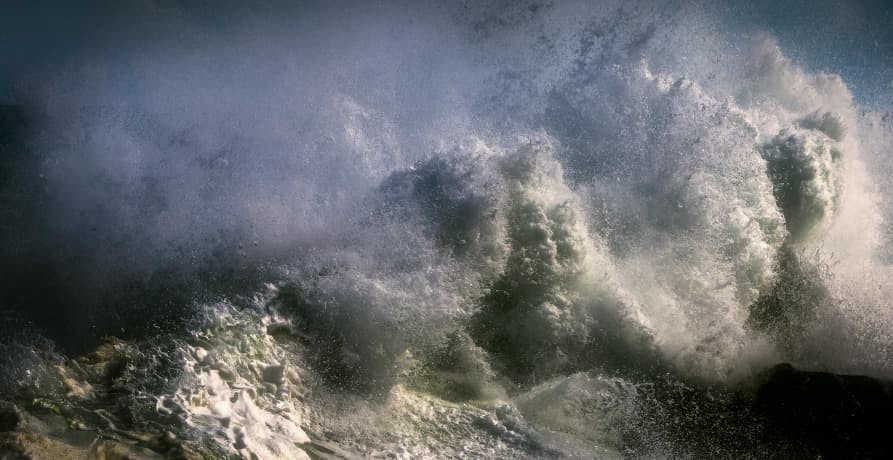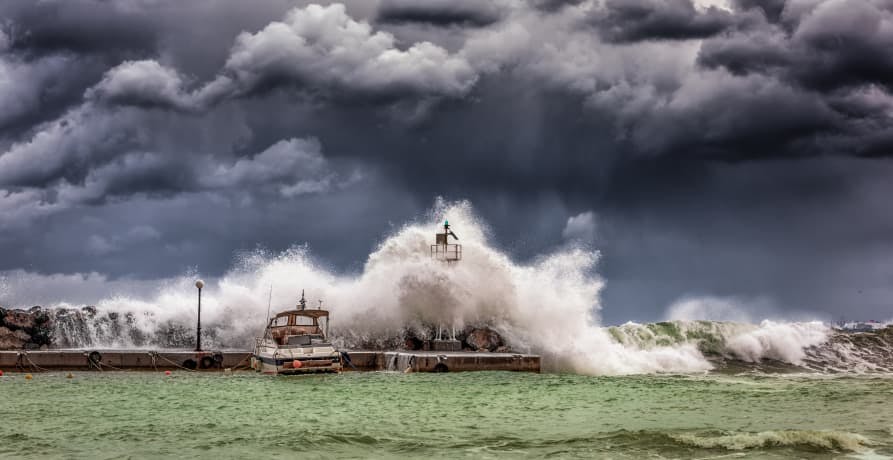ESG / CSR
Industries
Medicanes: the dangerous storms in the Mediterranean



The Mediterranean region - not traditionally known for severe weather events like hurricanes - has witnessed a notable increase in the severity of Mediterranean hurricanes, otherwise referred to as "medicanes." These rare yet powerful storms share characteristics with tropical cyclones, such as strong winds and heavy rainfall, which can lead to flash flooding, coastal floods, and wind damage.
Despite their smaller size and shorter duration than tropical cyclones, medicanes pose a significant threat to the Mediterranean basin, particularly its coastal communities and infrastructure. As the climate continues to deteriorate and sea temperatures rise, understanding, preparing for, and mitigating the impacts of these storms is becoming increasingly important.
👉 In this article we explore what causes a medicane, and why they're a growing threat in the Mediterranean region.
What is a medicane?
The term 'medicane' is a combination of the words ‘Mediterranean' and ‘hurricane', it describes the meteorological phenomenon of a Mediterranean tropical-like cyclone. The term is known to scientists and meteorologists but has only recently entered the public lexicon due to the rise in the frequency of these storms.
Medicanes are still a relatively rare occurrence when they do occur they're most likely to form between September and January and are more common in the western Mediterranean and the region found between the Ionian Sea and the North African coast. Unlike a true tropical cyclone, medicanes are usually non-tropical in nature, developing over open water under cold-core cyclones. It's this cold air that seems to form the instability leading to the development of a medicane.

How do medicanes form?
Medicanes, or Mediterranean hurricanes, originate through a unique combination of atmospheric dynamics and sea conditions. Unlike tropical hurricanes, which primarily develop over warm ocean waters, medicanes usually form in the autumn when cold air fronts from higher latitudes interact with a warm sea surface temperature in the Mediterranean. The process starts with an upper-level disturbance - usually a cold low-pressure system - bringing cold air into the region. When this colder air meets the warmer, moist air at the sea surface, convection is triggered, creating the first stages of a cyclonic storm.
As this system grows, the warm sea surface provides energy through latent heat, fueling the storm’s intensity. The formation of a central low-pressure zone allows winds to spiral inward, creating the characteristic cyclonic structure. For a medicane to fully develop, sea surface temperatures usually need to be around 20-26°C. These conditions, coupled with steady wind conditions (which would otherwise disrupt the storm formation), allow the system to intensify. As the storm strengthens, it may develop an eye-like structure and produce wind speeds similar to a Category 1 hurricane, though it typically remains smaller in size.
Medicanes are hybrid systems, initially powered by temperature contrasts and later by warm sea surface energy. This dual nature makes them unique, often transitioning from mid-latitude cyclones to systems with tropical characteristics. The entire process is sensitive to small shifts in temperature and atmospheric conditions, which is why medicanes are less frequent than other types of cyclones.
What's the difference between a hurricane and a medicane?
Medicanes, like hurricanes (i.e. tropical cyclones) develop spiraling clouds and a central ‘eye', which is an area of lighter winds and fairer weather at the center of the storm - on satellite imagery, this looks like a swirling mass of storm clouds surrounding a clear center.
However, medicanes tend to be smaller in diameter, have lower wind speeds, and die out quicker. Tropical cyclones (also referred to as hurricanes or typhoons) measure between 100 and 1000 km in diameter, have wind speeds of up to 320 kilometers per hour, and last a duration of anywhere between a day and a month. Medicanes on the other hand, will typically range between 70 and 200 km in size, have a wind speed of up to 144 km/h, and last for a duration of up to 3 days.
Another difference between the two is that medicanes form over the Mediterranean Sea, above waters with lower temperatures than the tropical oceans that give rise to hurricanes.
Hurricanes tend to form near the equator over high sea surface temperatures. They develop when a cluster of thunderstorms suck up the warm, humid air and push it high into the Earth's atmosphere. This warm air produces energy, allowing the hurricane's strong circular winds to form around a low-pressure center - i.e. the eye of the storm.
Medicanes on the other hand, usually develop when cold air intrusions move south over the Mediterranean Sea. The lower layers of the atmosphere heat over the warmer water, however, the upper atmosphere remains cold. This creates atmospheric instability resulting in thunderstorms, which can then develop into medicanes. These storms tend to form in the central and western parts of the Mediterranean and along the North African coastline.
Crucially, because of the smaller geographic area in which medicanes form, these storms are smaller and weaker than their tropical cousins, with maximum strength reaching no higher than a category 1 hurricane. However, that's not to say that these storms aren't dangerous.
| Feature | Medicanes | Tropical Cyclones (Hurricanes/Typhoons) |
|---|---|---|
| Formation Location | Mediterranean Sea | Tropical Oceans near the equator |
| Sea Surface Temperature | Cooler (20-26°C) | Warmer (over 26.5°C) |
| Size | 70-200 km in diameter | 100-1000 km in diameter |
| Wind Speed | Up to 144 km/h | Up to 320 km/h |
| Lifespan | 1-3 days | 1 day to over a month |
| Main Trigger | Cold air meeting warmer sea surface | Warm air and high humidity rising into the atmosphere |

What is the impact of a medicane?
Much like tropical cyclones, medicanes are also responsible for strong winds and large amounts of rain that cause damage such as flooding and landslides. In recent years we've seen a number of these destructive storms making landfall, though 2023 marked the most devastating medicane yet.
Storm Daniel (also referred to as Cyclone Daniel), which formed in September 2023 was particularly destructive. The medicane was the deadliest in recorded history, impacting Greece, Bulgaria, and Turkey before moving along the coast of Libya where it was responsible for catastrophic flooding.
It's estimated that the medicane has cost the Greek economy around 5 billion euros in short-term costs alone. However, it was Libya that was undoubtedly the worst hit by the storm. Torrential rain in the country put pressure on the country's water system, causing two dams near the city of Derna to collapse. There have been over 4,540 confirmed deaths resulting from the disaster.
Storm Daniel is a startling reminder of how much damage Mediterranean cyclones can cause. Medicanes bring with them a slew of potentially devastating impacts and associated risks, particularly in terms of flash flooding, coastal flooding, and extreme wind damage. Let's take a closer look at these risks:
Coastal flooding
The coastal regions are particularly susceptible to the impacts of medicanes, with the combination of strong winds and wave propagation leading to severe coastal flooding. This phenomenon not only poses a threat to coastal habitats and ecosystems but also endangers human settlements, critical infrastructure, and economic activities situated along the coast. The resulting damage can have far-reaching consequences, impeding the livelihoods of local communities and necessitating substantial recovery efforts.
Flash flooding
Medicanes are characterized by their ability to bring about a substantial surplus of rainfall within a short duration. This extreme rainfall can quickly overwhelm drainage systems, leading to flash floods that can wreak havoc on communities. The rapid rise of floodwaters can cause extensive material damage to infrastructure, homes, and businesses.
Extreme wind damage
Medicanes, with their potential to unleash wind gusts of up to 144 km/h, present a serious challenge to the structural integrity of buildings and infrastructure across the Mediterranean region. These extreme, hurricane-force winds can cause widespread damage, affecting not just roofs, but entire buildings, utility lines, trees, and more.
Disruption to agriculture
Flooding and strong winds can devastate agricultural lands, leading to significant crop loss and long-term soil degradation. This not only affects local farmers but can also disrupt food supplies and create economic challenges for the region.
Public health risks
Flooding from medicanes can lead to outbreaks of waterborne diseases, while damage to infrastructure often hinders access to clean water and healthcare. These combined factors can exacerbate the humanitarian impact of such storms.
Economic disruption
Beyond the immediate damage, medicanes disrupt local economies by affecting tourism, trade, and supply chains. The economic toll can linger long after the storm, impacting employment and the livelihoods of communities.
Environmental damage
Medicanes can cause erosion, loss of biodiversity, and contamination of ecosystems, particularly in coastal areas. The long-term environmental impacts can be difficult to reverse, leading to lasting ecological degradation.

Are medicanes getting worse due to climate change?
According to scientists, medicanes are getting more intense. This is because the temperature of the sea is rising as a result of climate change, creating more of a temperature difference between the warmer sea water and the cooler air trapped in the upper atmosphere. This gives more power to the cyclone.
Warmer water also results in increased rates of evaporation and higher moisture content, which makes the associated rainfall much more extreme. In fact, experts estimate that we're now experiencing 10 to 20% more rainfall compared to pre-industrialization medicanes.
Worryingly, global climate models show that medicanes are likely to become even more intense as a result of continued rising sea temperatures, with stronger winds and heavier rainfall predicted. Though, interestingly, the frequency of these storms is not expected to increase, in fact, according to the IPCC in their 6th Assessment Report “it is likely that medicanes will decrease in frequency, while the strongest medicanes become stronger under warming scenario projections”.
What can we do to reduce the impact of medicanes?
Even though scientists don't expect the Mediterranean basin to experience a higher number of medicanes, they are predicted to become more intense and dangerous, which raises the question: what can we do to reduce their impact and enhance resilience against these severe weather events?
To protect communities in the Mediterranean region from more extreme medicanes a multifaceted approach that encompasses preparedness, infrastructure upgrades, and community awareness is necessary. Let's examine what this means…
Enhanced early warning systems
Investing in advanced meteorological technologies and forecasting models can improve the accuracy and timeliness of weather predictions, providing crucial early warnings to affected regions. Rapid dissemination of information through various communication channels ensures that communities have sufficient time to prepare and evacuate if necessary.
Infrastructure resilience
Upgrading and reinforcing buildings, especially roofing structures, is vital to withstand the extreme winds associated with medicanes. Coastal defenses such as sea walls, breakwaters, and dunes can be enhanced or constructed to protect against storm surges and coastal flooding. Additionally, improving drainage systems helps to prevent and manage flash flooding effectively.
Urban planning and zoning
Implementing and enforcing strict building codes and zoning regulations can prevent construction in high-risk areas, particularly in flood-prone and coastal zones. Promoting the integration of green spaces and permeable surfaces in urban planning helps to reduce surface runoff and the risk of flooding.
Community preparedness and education
Raising awareness and educating communities about the risks and preparedness measures for medicanes is crucial. Conducting regular drills, distributing emergency preparedness kits, and establishing clear evacuation plans can empower residents to respond effectively in the event of a medicane.
Climate change mitigation
Addressing the broader issue of climate change, which contributes to the intensity and frequency of extreme weather events like medicanes, is essential. Adopting sustainable practices, transitioning to renewable energy sources, and reducing greenhouse gas emissions are key strategies for mitigating the long-term impacts of climate change.
Investment in research
Allocating resources to further research on Mediterranean cyclone characteristics - such as their patterns, behavior, and impacts - can provide valuable insights that inform better preparedness and response strategies. Collaboration between governments, scientific communities, and international organizations enhances knowledge sharing and the development of innovative solutions.
What about Greenly?
As extreme weather events like medicanes become more frequent and intense, it’s clear that businesses must also play a role in addressing climate change. Greenly offers a range of solutions to help companies reduce their carbon footprint and build resilience against the changing climate. From measuring greenhouse gas emissions to developing customized action plans, Greenly’s tools and expertise can guide your business toward more sustainable practices and contribute to global net-zero goals.
Comprehensive Carbon Management with Greenly
- Measurement of GHG Emissions: Track Scope 1, 2, and 3 emissions using advanced tools and technology for a full picture of your greenhouse gas footprint.
- Custom Action Plans: Work with Greenly’s climate experts to develop strategies focused on key areas for improvement. We help identify high-impact actions to reduce emissions and drive sustainable growth.
Decarbonising the Supply Chain
Supply chain emissions (Scope 3) are often the most challenging to manage but are critical for reaching net-zero goals. Greenly helps engage suppliers, transition to low-carbon options, and build more sustainable partnerships. With our support, you can increase transparency and reduce emissions across the supply chain.
Intuitive and Seamless Platform
Our user-friendly platform simplifies the process of calculating and monitoring your carbon footprint. Greenly provides a seamless experience for managing environmental impact, tracking progress against ESG goals, and integrating sustainability into every aspect of your operations.
Why Choose Greenly?
Greenly offers end-to-end support on your sustainability journey, from carbon measurement and custom action plans to supply chain decarbonization and easy platform integration. Partnering with Greenly can help significantly reduce your environmental impact and position your business as a leader in sustainability.
Start your journey toward net zero with Greenly today and help build a more sustainable future.






